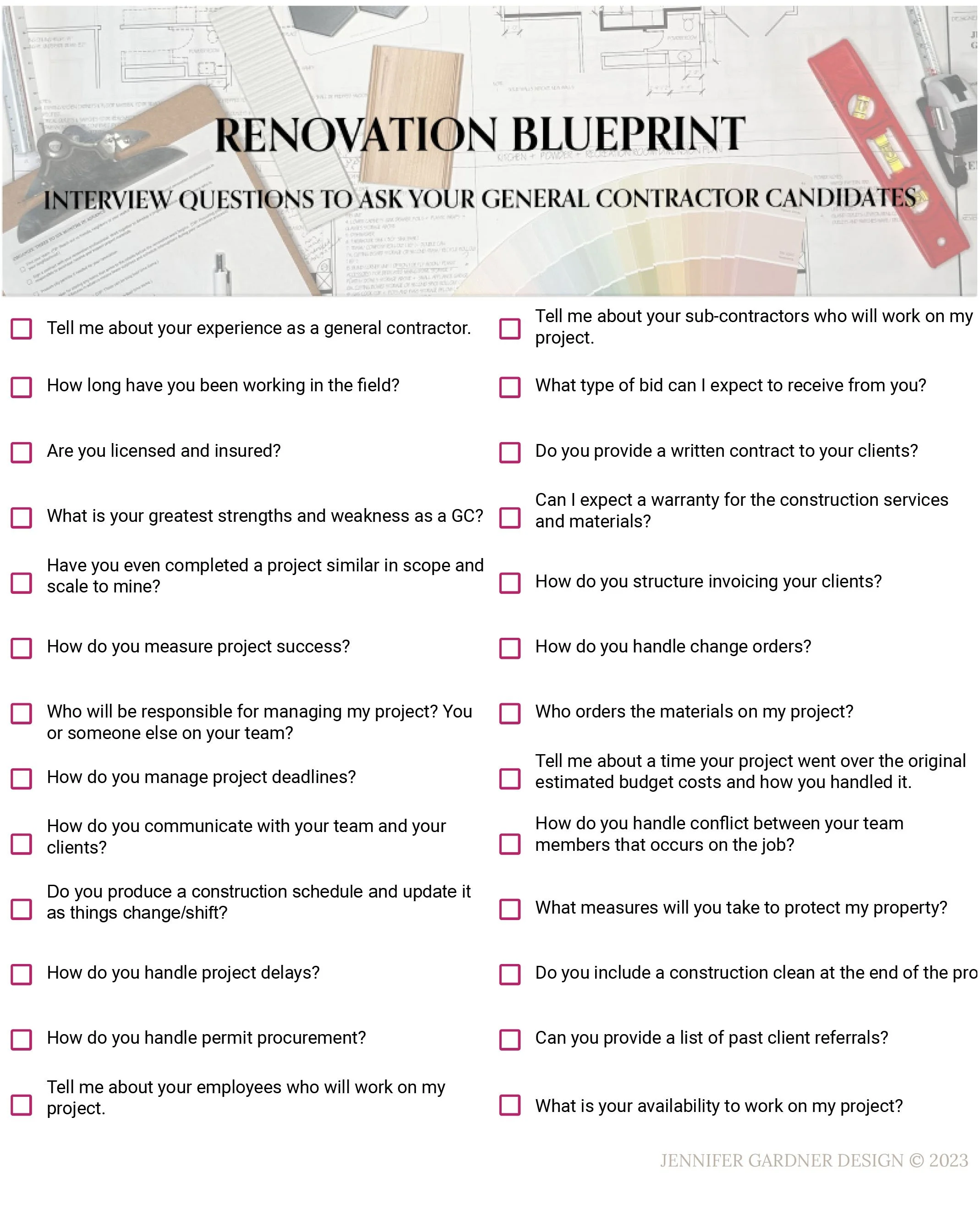Four Tips for Hiring a Rockstar General Contractor
Have you been following The Ultimate Home Renovation Checklist? If you have, and you’re finally through the design phase, then you are ready to bring in the pros!
As you start researching general contractors (GC) in your area, some questions may come up—including where the heck do you even begin? Never fear! I’m sharing my top tips to help you find and hire a rockstar general contractor.
Step One: Understand exactly what you need
Depending on where you live, you may be able to choose between small, mid-sized, and large-scale GC options. There are pros and cons to each.
A mid-size to large operation often includes a dedicated project manager and a team of laborers ready to tackle your job. They might be able to get the job done quickly. However, those perks may come at a higher price point or mean that you can’t live in your space while the work is being done.
A smaller operation might consist of one person and their sub-contractors. This group might take longer to get the job done but might be less expensive due to lower overhead. They also may be more flexible in terms of working around you if you need to live in the home during the project.
Step Two: Research and make a shortlist
I generally recommend that my clients speak to three to five general contractor candidates and request bids from at least three. The best place to start the search for your rock star general contractor is with friends and neighbors.
Has anyone in your life had a great experience with a GC worth adding to your shortlist? Similarly, has anyone had a #RenovationNightmare advising you against working with a particular group? If you still need GC names after going through this exercise, I suggest searching your local Facebook groups, Angie’s List, or your neighborhood Nextdoor app to look at reviews.
Once you have chosen three reputable GCs—now what? First things first, schedule a meeting with each of the contractor groups. If you have a digital set of plans and specifications for the project, it is helpful for each group to see those ahead of the meeting. The more information they have up front, the more productive your meeting will be.
Step Three: Set up the interviews
Plan at least an hour, depending on the scale of your project, to interview each group in your home. Meeting in the place where the renovation work will happen allows the general contractors to get a sense of the size and scope of the project.
Generate a list of questions ahead of the meeting and plan to ask the same questions to each group. Take notes and keep a record of the responses. You may want to revisit the notes when the bids start rolling in.
Not sure what questions to ask? We have created a list for you below.
Pro Tip: Have a printed set of plans and physical samples of your materials out and ready to review. These essential elements will help to facilitate a meaningful conversation about your project.
Bonus Pro Tip: You are going to spend a lot of time with your contractor. It is really important that you both feel like the project and the time spent together will be a good fit.
Step Four: Collect the bids
Following your meeting, if you and the contractor both feel that the project is a good fit, you can request that they put a bid together for your project. This is an estimate of the cost to get your job done.
You might be wondering how many bids to request. A general rule of thumb is three bids per project. You will notice that no two bids will look exactly the same.
The four most common types of contracts I see include:
Time and Materials (T&M): All labor and material costs are reflected in this contract style, and it is frequently used when the scope of work is loosely defined. This contract ensures that the contractor gets reimbursed. However, it can be risky for the homeowner who may not have a clear picture of the amount of money they will spend on the renovation.
Cost-Plus: Similar to a T&M contract, the contractor is reimbursed for all labor and material costs. In addition, the homeowner agrees to pay an additional amount for the profit. This can be listed as a percentage added to the contract's bottom line.
Lump Sum Contracts: This contract style includes a fixed dollar amount for your project. In order to develop a lump sum contract, your project scope needs to be well-defined and include all drawings, materials, and fixture selections before collecting your bids. The contractor will most likely walk through with their subcontractors to develop hard numbers around your scope of work. This style of contract can be advantageous to the homeowner in terms of understanding the total project cost but can also mean higher profit margins built in to cover all costs and an overall higher project cost. If changes occur during the work, a change order should be submitted to the homeowner for approval before the work is completed.
Guaranteed Maximum Price Contracts: These contracts require a clearly defined scope of work similar to the lump sum option. The contractor sets the project cost ceiling based on a set scope of work. The homeowner agrees to the maximum price. If any changes are made to the scope during the project, the homeowner can expect to approve a change order before the work is completed. This change order is outside of the maximum price contract.
I recommend that you discuss the bid types with each of the candidates at the first meeting so expectations are clear. If you require that each contractor submit the same bid style and it is not a type they typically provide, they may opt to pass on bidding for your project.
Pro Tip: If your contractor’s standard is a T&M or Cost Plus contract, you can ask for a not-to-exceed clause to avoid overspending. In addition, you can ask for a detailed monthly invoice outlining all hourly labor costs and materials invoices. Lastly, I strongly advise that you use a budget spreadsheet to track your costs throughout your project.
The exception to the three-bid rule
There’s an exception to every rule—including the three-bid rule! Picture the scene: your mother, sister, and best friend have all worked with a contractor who they unanimously consider to be a rockstar contractor. He is fair, does incredible work, brings in reliable subs, and is generally very nice to be around. This GC is a one-man show and is booked out for a year or more. He is 100% referral-based, and while he is happy to put together an estimate for his referrals, he prefers not to get involved in a bidding competition. This gem of a GC is the exception to my earlier recommendation of getting three bids for your project.
And just like that—your renovation begins!
Bids are in, and after careful consideration and possibly some negotiation, you select and hire your rockstar general contractor. Pop the prosecco and celebrate the official start of your project’s renovation phase!
Did you find this post helpful? Be sure to sign up for our newsletter so you never miss my tips for planning, organizing, and managing your home renovation project like a pro!

